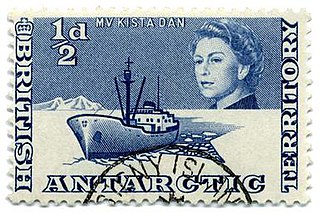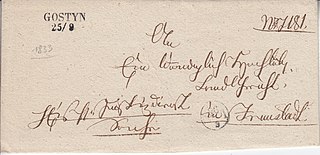History

Australia has issued postage stamps for the Australian Antarctic Territory since 1957. All have been Antarctic themed, and are also valid for postage in Australia, so in practice, they are just Australian stamps with a different inscription. The Australian Antarctic Territory Act (1954) allowed for a postage system to be introduced in 1955, under the commonwealth and after the territory had commenced philatelic colonialism. [1] The introduction of the system produced both a postmark and postcard, which could be used both on mainland Australia (for postage all over the country, not specifically to the Antarctic Territory) or from the Territory itself. [1]
Post
Past postage systems
Before the Australian Antarctic Territory Act was signed in 1954, all expeditions to Antarctica were customised with different rubber postage stamps, due to the adhesive postage stamp being not yet used amongst society. For the Australian Antarctic Expedition, 1911–14, [2] commandeered and under the leadership of Sir Douglas Mawson [2] a stamp was commissioned in order to show that letters were being sent from the ship used to travel to Antarctica. The stamps were round, with an emperor penguin and the inscription “LOOSE SHIP’S LETTER/POSTED IN ANTARCTICA/S.Y. AURORA”. [2] All letters leaving from the S.Y. Aurora were stamped with an Australian stamp, which was then covered with the official expedition stamp in order to show the location from which they were sent from. [2]
This system was adjusted in 1955 when the first post office was established in MacRobertson Land (Mawson Station), where letters were stamped with adhesive stamps and sent via plane or ship to mainland Australia, where they were sorted and distributed across the country.
However, when expeditions were organised, such as the South Indian Ocean Expedition to Heard Island (1964–65) and the Australian National Antarctic Research Expeditions (1947–65), [2] rubber stamps were also commissioned, often featuring penguins, in order to clearly identify where letters were arriving from in the sorting office in mainland Australia.
Australian Antarctic Territory postage stamps
In the past, until approximately 1970, stamps were issued in both Australia and the Australian Antarctic Territory, and were available in Australian post offices for two weeks before being “procurable at the [Australia Post] Department’s philatelic sections in all States”, [3] in order to increase interest around the Antarctic discoveries for Australia. However, after this period, stamps for the Territory were issued in both Australia and the Australian Antarctic Territory, [4] yet limited in Australia to a small amount of stock which could be bought at Australia Post Offices. Throughout both periods, all stamps were still valid after their sale in both Australia and the Australian Antarctic Territory.
Past stamp designs

Antarctic Research Commemorative Stamp: (Australian release only)
On the 17th of November 1954, [2] prior to the commencement of the postage system in the Australian Antarctic Territory, a stamp to commemorate the discoveries made and expeditions by
Australians within the Territory was issued throughout mainland Australia. [2] As pictured, it featured several important flora and fauna relevant to certain discoveries, including;
- Black-bowed Albatross (Domeda Melanorphris) (Temminck)
- Kerguelen Cabbage (Pringlea antiscorbutica)
- King Penguin (Aptenodytes patagonica)
- 2 fish breeds; (Cygnodraco mawasoni) and (Notothenia macrocephala)
- Elephant Seal (Miroungra leonine) (Linn)
- Crustaceans (Zooplankton)
- Gentoo Penguin (Pygoscelia papua (Forster)
- Coastal bog plant (Pleurophylum hookeri (Buch))


















